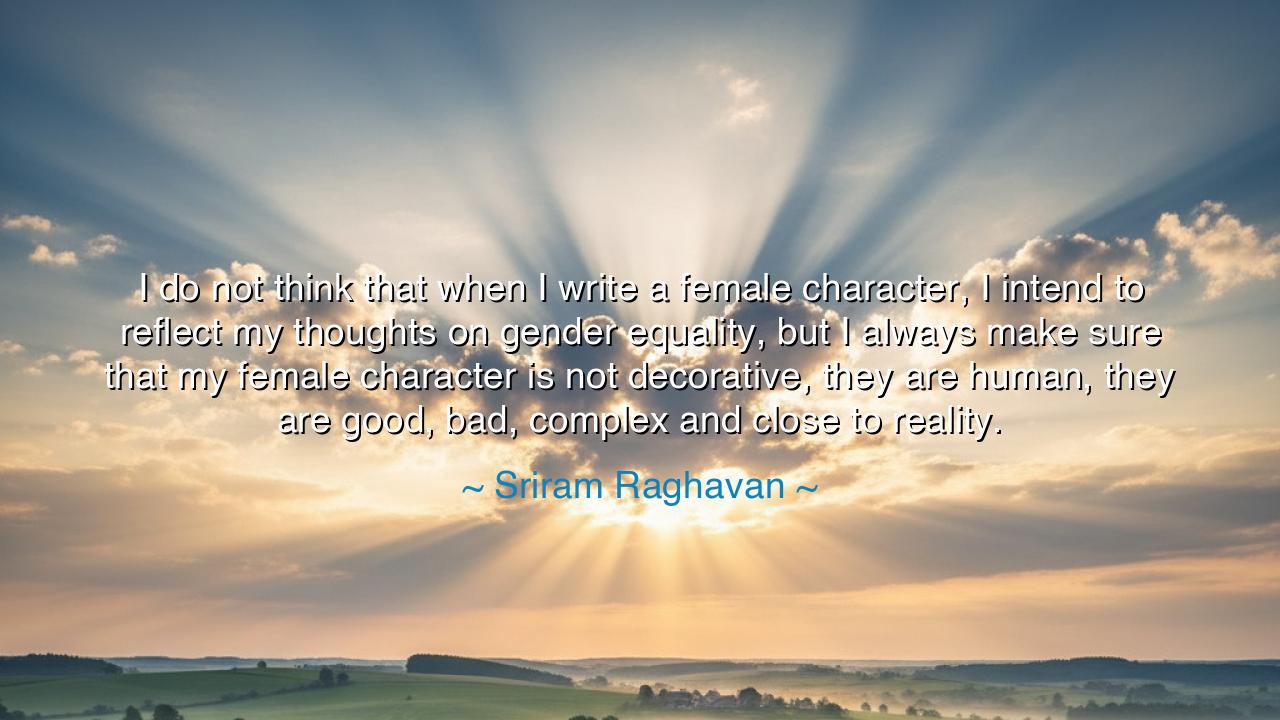
I do not think that when I write a female character, I intend to
I do not think that when I write a female character, I intend to reflect my thoughts on gender equality, but I always make sure that my female character is not decorative, they are human, they are good, bad, complex and close to reality.






In the art of storytelling, the creation of a character is a sacred endeavor, a reflection of the storyteller’s desire to capture the fullness of the human experience. Sriram Raghavan’s words, “I do not think that when I write a female character, I intend to reflect my thoughts on gender equality, but I always make sure that my female character is not decorative, they are human, they are good, bad, complex, and close to reality,” offer a profound perspective on the craft of character creation. His intention is not merely to conform to the ideals of gender equality, but to create female characters who are authentic, not bound by stereotype or simplicity. They are multifaceted beings, embodying the complexities of human nature, as are their male counterparts, who hold the same right to complexity, imperfection, and depth.
The ancients too understood the importance of creating characters that transcended the boundaries of simple archetypes. In Greek mythology, figures such as Athena, the goddess of wisdom, and Penelope, the wife of Odysseus, were complex and multi-dimensional, reflecting the varied and often contradictory nature of the human experience. Athena, though a goddess of war and wisdom, showed the vulnerability of the intellect, and Penelope, through her unwavering loyalty to her husband, also displayed strength, intelligence, and a capacity for independent action. These ancient figures, though mythological, were portrayed as more than mere symbols of their roles; they were endowed with the qualities of human complexity—strength, fear, love, and sorrow—each embodying a fuller, more realistic existence than mere decorative symbols.
In the same vein, Sriram Raghavan's female characters must be seen as representations of this complexity. They are not to be pigeonholed into simple roles that fit into preconceived notions of gender or societal expectations. Rather, they are human beings, capable of the same contradictions, flaws, and virtues that we expect in male characters. In this, Raghavan follows a tradition that was already present in the epic literature of the ancients, where female characters were not confined to the role of mere symbols but were imbued with the fullness of human complexity. Sita in the Ramayana, for example, is not just a symbol of the dutiful wife but also a woman of immense strength, independence, and inner resolve. She challenges the conventions of her time, and like the women in Raghavan’s stories, she is good, bad, complex, and deeply human.
The creation of characters who are real and whole, as Raghavan advocates, is an act of truth-telling. The ancient Greeks prized philosophers who could see beyond the surface, who could penetrate to the true nature of things. Plato, in his Republic, discussed the concept of justice, and how it must transcend appearances and dig into the soul of the individual. Socrates himself was revered for his ability to ask the most penetrating questions, forcing people to confront not just what they thought they believed, but the depth and complexity of their beliefs. In creating complex female characters, Raghavan is doing much the same. He is refusing to accept the surface narrative and is seeking a deeper, truer representation of the human experience, particularly as it pertains to the lives of women.
Consider the example of Jane Austen, a writer from a very different time, but one whose female characters are some of the most beloved and revered in all of literature. Characters like Elizabeth Bennet in Pride and Prejudice or Elinor Dashwood in Sense and Sensibility are not simply reflections of their gender or their time. They are complex individuals, whose inner lives, desires, and personal struggles reflect the full spectrum of the human condition. These characters defy simple categorization: they are strong, yet they have moments of vulnerability; they are independent, yet deeply relational; they are rational, yet capable of passion. Just as Austen elevated the inner lives of her female characters, Raghavan seeks to elevate the depiction of women, creating individuals whose humanity is felt in every word and action.
In our own world, where stories continue to shape the ways we understand ourselves, the lesson from Raghavan’s words is clear: humanity cannot be contained in rigid roles or stereotypes. Whether male or female, each person carries the full weight of complexity—strength, weakness, virtue, and flaw. By honoring the fullness of human experience in storytelling, we open the door to greater empathy and understanding. It is not enough to simply portray women as symbols of a moral or ideological point; they, like men, must be given the space to live and breathe as fully realized characters, capable of inspiring the full spectrum of emotion.
In our own lives, let us embrace the complexity of those around us, especially in how we view and treat women. Let us resist the temptation to simplify or stereotype individuals based on their gender, their race, or any other social construct. Just as Raghavan’s female characters are real, with all their complexities, so too are we all multifaceted beings, worthy of being seen in our fullness. We must seek to understand the humanity of others, not in terms of the roles they occupy but in the full scope of their lives and experiences. The stories we tell—whether in literature, film, or in our own lives—should reflect this depth, honoring the truth of the human spirit in all its dimensions.






AAdministratorAdministrator
Welcome, honored guests. Please leave a comment, we will respond soon